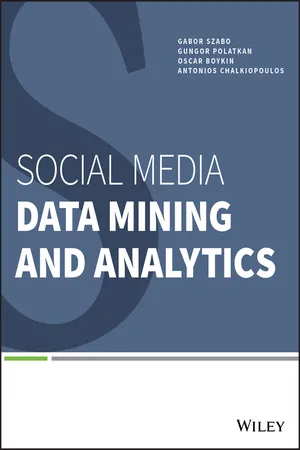
Social Media Data Mining and Analytics
- English
- ePUB (mobile friendly)
- Available on iOS & Android
Social Media Data Mining and Analytics
About this book
Harness the power of social media to predict customer behavior and improve sales
Social media is the biggest source of Big Data. Because of this, 90% of Fortune 500 companies are investing in Big Data initiatives that will help them predict consumer behavior to produce better sales results. Social Media Data Mining and Analytics shows analysts how to use sophisticated techniques to mine social media data, obtaining the information they need to generate amazing results for their businesses.
Social Media Data Mining and Analytics isn't just another book on the business case for social media. Rather, this book provides hands-on examples for applying state-of-the-art tools and technologies to mine social media - examples include Twitter, Wikipedia, Stack Exchange, LiveJournal, movie reviews, and other rich data sources. In it, you will learn:
- The four key characteristics of online services-users, social networks, actions, and content
- The full data discovery lifecycle-data extraction, storage, analysis, and visualization
- How to work with code and extract data to create solutions
- How to use Big Data to make accurate customer predictions
- How to personalize the social media experience using machine learning
Using the techniques the authors detail will provide organizations the competitive advantage they need to harness the rich data available from social media platforms.
Frequently asked questions
- Essential is ideal for learners and professionals who enjoy exploring a wide range of subjects. Access the Essential Library with 800,000+ trusted titles and best-sellers across business, personal growth, and the humanities. Includes unlimited reading time and Standard Read Aloud voice.
- Complete: Perfect for advanced learners and researchers needing full, unrestricted access. Unlock 1.4M+ books across hundreds of subjects, including academic and specialized titles. The Complete Plan also includes advanced features like Premium Read Aloud and Research Assistant.
Please note we cannot support devices running on iOS 13 and Android 7 or earlier. Learn more about using the app.
Information
CHAPTER 1
Users: The Who of Social Media
Measuring Variations in User Behavior in Wikipedia

The Diversity of User Activities
Table of contents
- Cover
- Table of Contents
- Introduction
- CHAPTER 1: Users: The Who of Social Media
- CHAPTER 2: Networks: The How of Social Media
- CHAPTER 3: Temporal Processes: The When of Social Media
- CHAPTER 4: Content: The What of Social Media
- CHAPTER 5: Processing Large Datasets
- CHAPTER 6: Learn, Map, and Recommend
- CHAPTER 7: Conclusions
- Index
- End User License Agreement